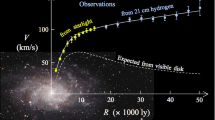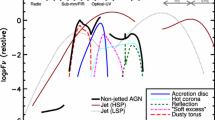Abstract
I review the origin of UV-radiation in galaxies of different morphological types. UV-excess in spectra of massive elliptical galaxies which have predominantly old stellar populations is traditionally explained by the contribution of low-mass stars at very late, poorly known stages of evolution—by so called ‘AGB-manqué’ stars or by the population of extended horizontal branch. However recent results from the GALEX survey of a large sample of nearby ellipticals have also demonstrated probable traces of recent star formation in a third of all ellipticals observed. In spiral galaxies extended UV-disks have been discovered by the GALEX; they are certainly illuminated by the current star formation, but what has provoked star formation in the areas of very low gas density, beyond the distribution of older stars, is a puzzle yet. The UV-spectra of starburst galaxies or starforming galactic nuclei are characterized by weak emission lines, if any, quite dissimilar to their optical spectra.
Similar content being viewed by others
References
Atlee, D.W., Assef, R.J., Kochanek, C.S.: Astrophys. J. 694, 1539 (2009)
Bertola, F., Capaccioli, M.: Mem. Soc. Astron. Ital. 54, 415 (1983)
Bertola, F., Capaccioli, M., Holm, A.V., Oke, J.B.: Astrophys. J. Lett. 237, L65 (1980)
Bertola, F., Capaccioli, M., Oke, J.B.: Astrophys. J. 254, 494 (1982)
Bohlin, R.C., Cornett, R.H., Hill, J.K., Smith, A.M., Stecher, T.P.: Astrophys. J. Lett. 274, L53 (1983)
Boissier, S., Gil de Paz, A., Boselli, A., Madore, B.F., Buat, V., et al.: Astrophys. J. Suppl. Ser. 173, 524 (2007)
Brocato, E., Matteucci, F., Mazzitelli, I., Tornambe, A.: Astrophys. J. 349, 458 (1990)
Brown, T.M., Ferguson, H.C., Davidsen, A.F., Dorman, B.: Astrophys. J. 482, 685 (1997)
Bruzual, G., Charlot, S.: Mon. Not. R. Astron. Soc. 344, 1000 (2003)
Burstein, D., Bertola, F., Buson, L.M., Faber, S.M., Lauer, T.R.: Astrophys. J. 328, 440 (1988)
Bush, S.J., Cox, T.J., Hayward, C.C., Thilker, D., Hernquist, L., Besla, G.: Astrophys. J. 713, 780 (2010)
Busso, G., Cassisi, S., Piotto, G., Castellani, M., Romaniello, M., et al.: Astron. Astrophys. 474, 105 (2007)
Code, A.D., Welch, G.A.: Astrophys. J. 228, 95 (1979)
Code, A.D., Houck, T.E., McNall, J.F., Bless, R.C., Lillie, C.F.: Astrophys. J. 161, 377 (1970)
Cortese, L., Boselli, A., Franzetti, P., Decarli, R., Gavazzi, G., et al.: Mon. Not. R. Astron. Soc. 386, 1157 (2008)
Deharveng, J.-M., Boselli, A., Donas, J.: Astron. Astrophys. 393, 843 (2002)
Dorman, B., O’Connell, R.W., Rood, R.T.: Astrophys. J. 442, 105 (1995)
Dow-Hygelund, C.C., Holden, B.P., Bouwens, R.J., van der Wel, A., Illingworth, G.D., et al.: Astrophys. J. Lett. 630, L137 (2005)
Freeman, K.C.: Astrophys. J. 160, 811 (1970)
Gil de Paz, A., Madore, B.F., Boissier, S., Swaters, R., Popescu, C.C., et al.: Astrophys. J. Lett. 627, L29 (2005)
Gil de Paz, A., Boissier, S., Madore, B.F., Seibert, M., Joe, Y.H., et al.: Astrophys. J. Suppl. Ser. 173, 185 (2007)
Greggio, L., Renzini, A.: Astrophys. J. 364, 35 (1990)
Horch, E., Demarque, P., Pinsonneault, M.: Astrophys. J. Lett. 388, L53 (1992)
Jeong, H., Bureau, M., Yi, S.K., Krajnovic, D., Davies, R.L.: Mon. Not. R. Astron. Soc. 376, 1021 (2007)
Kaluzny, J., Udalski, A.: Acta Astron. 42, 29 (1992)
Kennicutt, R.C., Jr.: Astrophys. J. 344, 685 (1989)
Kennicutt, R.C., Jr.: Astrophys. J. 498, 541 (1998)
Kinney, A.L., Bohlin, R.C., Calzetti, D., Panagia, N., Wyse, R.F.G.: Astrophys. J. Suppl. Ser. 86, 5 (1993)
Liebert, J., Saffer, R.A., Green, E.M.: Astron. J. 107, 1408 (1994)
Loubser, S.I., Sanchez-Blazquez, P.: Mon. Not. R. Astron. Soc. 410, 2679 (2011)
Marino, A., Rampazzo, R., Bianchi, L., Annibali, F., Bressan, A., et al.: Mon. Not. R. Astron. Soc. 411, 311 (2011)
Martin, C.L., Kennicutt, R.C., Jr.: Astrophys. J. 555, 301 (2001)
Ohl, R.G., O’Connell, R.W., Bohlin, R.C., Collins, N.R., Dorman, B., et al.: Astrophys. J. Lett. 505, L11 (1998)
Oke, J.B., Bertola, F., Capaccioli, M.: Astrophys. J. 243, 453 (1981)
Peng, F., Nagai, D.: Astrophys. J. Lett. 705, L58 (2009)
Rampazzo, R., Marino, A., Tantalo, R., Bettoni, D., Buson, L.M., et al.: Mon. Not. R. Astron. Soc. 381, 245 (2007)
Ree, C.J., Lee, Y.-W., Yi, S.K., Yoon, S.-J., Rich, R.M., et al.: Astrophys. J. Suppl. Ser. 173, 607 (2007)
Rich, R.M., Minniti, D., Liebert, J.: Astrophys. J. 406, 489 (1993)
Rich, R.M., Salim, S., Brinchmann, J., Charlot, S., Seibert, M., et al.: Astrophys. J. Lett. 619, L107 (2005)
Sage, L.J., Welch, G.A., Young, L.M.: Astrophys. J. 657, 232 (2007)
Salim, S., Rich, R.M.: Astrophys. J. Lett. 714, L290 (2010)
Shapley, A.E., Steidel, C.C., Pettini, M., Adelberger, K.L.: Astrophys. J. 588, 65 (2003)
Shawinski, K., Kaviraj, S., Khochfar, S., Yoon, S.-J., Yi, S.K., et al.: Astrophys. J. Suppl. Ser. 173, 512 (2007)
Sil’chenko, O.K., Afanasiev, V.L.: Astron. Rep. 52, 875 (2008)
Thilker, D.A., Bianchi, L., Meurer, G., Gil de Paz, A., Boissier, S., et al.: Astrophys. J. Suppl. Ser. 173, 538 (2007)
Veilleux, S., Osterbrock, D.E.: Astrophys. J. Suppl. Ser. 63, 295 (1987)
Vlasyuk, V.V., Sil’chenko, O.K.: Astron. Astrophys. 354, 28 (2000)
Weedman, D.W., Feldman, F.R., Balzano, V.A., Ramsey, L.W., et al.: Astrophys. J. 248, 105 (1981)
Wiklind, T., Combes, F., Henkel, C.: Astron. Astrophys. 297, 643 (1995)
Yi, S., Demarque, P., Oemler, A., Jr.: Astrophys. J. 486, 201 (1997)
Yi, S., Lee, Y.-W., Woo, J.-H., Park, J.-H., et al.: Astrophys. J. 513, 128 (1999)
Yong, H., Demarque, P., Yi, S.: Astrophys. J. 539, 928 (2000)
Author information
Authors and Affiliations
Corresponding author
Rights and permissions
About this article
Cite this article
Sil’chenko, O.K. UV-radiation in galaxies. Astrophys Space Sci 335, 171–176 (2011). https://doi.org/10.1007/s10509-011-0639-4
Received:
Accepted:
Published:
Issue Date:
DOI: https://doi.org/10.1007/s10509-011-0639-4




